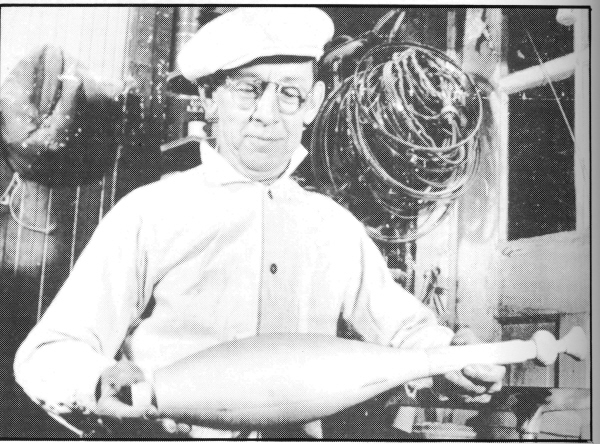
Harry
Lind in his workshop. Photo courtesy Karl-Heinz Ziethen from "4,000 Years of Juggling." |
Page 54 Summer 1987
|
Prior
to the Van Wyck club, clubs were painted by the performers
Van
Wyck's introduced lighter, foil decoration. But his greatest
contribution was to take the club away from the haphazard production
of the local wood turner and place more control over the balance of
the club.
Previously,
performers might order twice as many clubs as they needed in order
to select a set with proper balance. But Van Wyck made the club
sturdier without increasing the weight. The interior construction
was at first solid white pine. In 1887 he introduced hollow clubs
weighing just 24 ounces, and later brought the weight down to 18
ounces. The price was $1.50.
Before
Van Wyck, the handles were
He
continued to make clubs through 1942. The last performer he provided
with Harry
Lind In the family of American juggling, Harry Lind was the grandfather, the patriarch of a growing clan. He was an indispensable manufacturer of clubs, counselor, inspiration and one of the prime movers in founding the IJA.
He
was born in 1879 in Jamestown,
Lind's
devotion to juggling was a return on a gift it had given him - it
had saved his life. As a young boy working in a furniture factory,
he was riding in a freight elevator when a broken cable whip-snapped
down on him, putting him near death for a month and partially
paralyzing him.
His
therapy was to swing one Indian club gently in his weakened hand,
then increase the arc. He slowly regained the use of his arms, in
spite of the doctor's verdict that he'd never use them again.
He
made his debut on Oct. I, 1900, at Nate Fenton's Pekin Restaurant
Lind's
act was one of the first full club swinging routines in vaudeville.
He also did three and four club juggling. Harry and Eugene, who was
a flute player with a minstrel show, traveled in circuits together
for some 18 years until Eugene
contracted tuberculosis. Both men returned home and Eugene
later died.
Lind
had several other partners in his acts through the years, but none
lasted more than a year, due apparently to Lind's demand for
practice and perfection. He had brought his parents' work ethic to
his chosen profession and few others could live with the demands he
placed on them and himself.
When
he retired in 1919, he tried his hand at interior decorating and
soon opened his own manufacturing shop with machinery purchased from
Van Wyck. His shop in
It
was crammed with a dozen machines
Lind
fine tuned the weight control of clubs. He had more of a woodworking
background than Van Wyck and was able to choose wood stock by grain
and density to achieve more uniform balance.
Both
the Van Wyck and Lind clubs were made of a three-piece construction.
The two pieces of the Van Wyck bodies consisted of a hollowed cup
joined by glue to the upper part of the body, with the handle then
inserted and fastened with the wooden nut and glue. Lind's two
pieces were like slats or ribs running lengthwise, to which the
handle was wedged. He then covered the body with canvas and wrapped
the neck with glue-impregnated cord.
The canvas was occasionally painted and the handles were oiled and polished. The ribs of the body were basswood, from the linden tree that was common in his area. The handles were maple or ash. |

Harry
Lind in his workshop. Photo courtesy Karl-Heinz Ziethen from "4,000 Years of Juggling." |